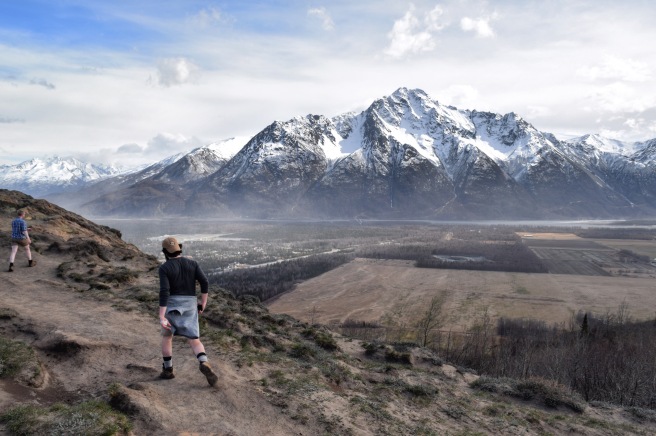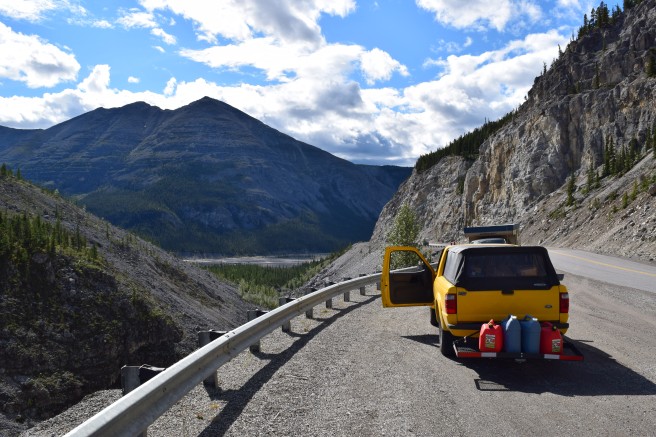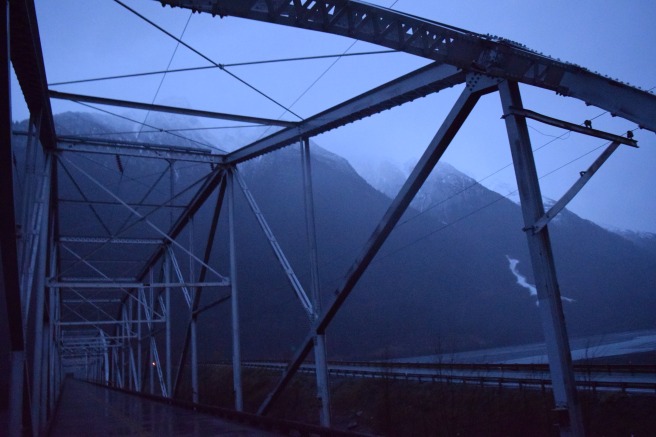Down the old highway. Past the sign full of bullet holes that says ‘no fireworks’. And the one that tells you about hidden driveways for the next few miles. Turn onto the road that is some sort of gravel or dirt or mud. And pull into the rocky loop framed with railroad ties. That is where I live. Where the once trees were laid to rest in rectangular fashion, one atop the other eleven high and as long as the treetops. At night the cabin is vocal as it settles in for the evening. By day it sits and watches over the lawn, a little greenhouse and two and a half sheds. The chimney is hung from the sky by a single, narrow thread of pine smoke that tangles with the low hanging clouds. The lawn is mostly moss.
When I step out on the front porch I am in the shadow of a great mountain. When I look up I see avalanche streaks down her face. Even when I go to the mechanic in Wasilla or the alehouse in Palmer, I see her distinctive features in the distance and know home is waiting for me at her feet. From the back porch I can almost see the Knik River lying peacefully, just before her tributaries part ways and head up to their sources at Matanuska Glacier and beyond. If you follow the flow of the river west, she joins the Knik Arm which together with the Turnagain Arm form into Cook Inlet. Jutting out into the Inlet, nestled between the two Arms is a peninsular landmass upon which sits the city of Anchorage.
Three days ago, I was driving to work on the old winding highway covered in snow; it was dark. As I was coming around one of the bends that warns you to slow down, I saw a large mass in the middle of the road. I slowed the vehicle as quickly and safely as I could given the icy state of affairs and finally came to a stop a few feet from two moose. One of them apparently had experience with vehicles and hurriedly went over the guardrail and down the hill into the darkness. The other, it seemed, was less familiar with the concept of cars — or perhaps she was just smart enough to know that there was nothing I could do to get her to move. Either way, she stood with her rear to me (which was above eye level) and made no signs of acknowledging my presence. After a few moments of wonder —for this was my first encounter with moose— I began edging the vehicle towards the moose. She finally took notice and moved forward a few feet, as if she were standing in a place I wanted to occupy and not pass through, so I continued at my snails pace until eventually she realized my intentions or tired of her stubbornness and lumbered over the guardrail out of sight.
While she had been blocking my route to work and as she left, I admired her mythic form. Moose are incredible beasts. I knew this conceptually. The Alaska subspecies (the biggest in the world) can stand over two meters tall and weigh an average of 1400 pounds. A while back I went to a class on how to butcher a caribou —a process that yields about 80-100 pounds of meat— and they talked about how a single moose could yield over 500 pounds of meat. But none of this theoretical knowledge of the size of a moose prepared me for actually seeing one. More than any other animal I’ve encountered, you can see the weight of the moose. You can feel the weight in the way it walks with its shrugged shoulders and colossal hips. Even the herds of buffalo (the only North American animal that is larger than a moose) that I have seen in western Canada don’t compare. Perhaps the giraffes I saw in Kenya come close, but still they seemed to almost glide unless you can see the movement of their legs while they gallop. A moose has presence and weight.
The next morning when I drove to work there were eight more inches of snow on the ground, the most we have had so far this year. It was early, around two in the morning, and the highway near my house doesn’t get a whole lot of traffic, so the snow was thick on the roads. I cautiously drove its crooked route toward the Glenn (the main highway in Alaska) and eagerly awaited the relief that comes from getting to a more heavily trafficked road. But as I turned down ramp that merges onto the Glenn I was greeted by no such relief. During past snowfalls, even when the snow is its freshest, the traffic on the highway has left a path cut through the snow, two sometimes four tire tracks for others to follow into town. Today there were none — or, I guess, a lot. Instead of the normal group effort to forge a few clear paths, everyone had taken a slightly different route through the snow and the resulting surface before me was, quite frankly, terrible. There were ruts and icy patches and ridges of snow cover the highway, all the way to Anchorage. There is a quiet assumption that we make when we drive, especially on winding roads or high speed freeways, that the path is clear. We assume, without even thinking about it, that the road is clear and safe and there. And this is a safe assumption because it always is. But if you think about it, it is a bit surprising what we do, barreling down roads in fiberglass boxes at 60 and 70 miles per hour or more. You might start to realize that you make this assumption when you are driving down two narrow tire paths in the snow, that could at any moment give way to an ice sheet. And —if you ever find yourself on a highway covered in snow with no paths cut and cross winds that make ribbons of snowflakes dance and twirl across a white sheet, three lanes wide with no discernible markers or indication of where the road ends and the median begins— you are unable to avoid confronting that implicit fact that you normally take for granted.
This was maybe the fourth or fifth snowfall of the year, for the first few I had regular old run of the mill tires. And it was horrifying. I drive a small yellow two wheel drive pickup truck and it doesn’t handle snow well. Don’t get me wrong, Cheech is a trooper, but he has zero traction. During the first snowfall (okay, actually the second, there was one in September but that one doesn’t count), when I was driving home the entire Glenn Highway was an ice sheet. I was rolling down the highway, topping out at speeds of 30 mph and fishtailing all the way to the cabin. I was just trying to find and stay in one of the few tracks that were relatively clear and not run off the road. Big trucks and four wheel drive SUVs were zipping past me, their drivers giving me looks like I was mad. All the while the sides of the road were littered with vehicles that had slid off the highway or simply been abandoned in snowdrifts. When I got home, I learned that almost 100 cars had lost control and gone off the road or crashed that day.
In general, I don’t like impatient drivers, people that speed around other cars, passing unnecessarily in the right lane, and making the roads a little bit more dangerous for everyone else. Surely, I thought, people will be more understanding in the snow, when conditions are dicey. But, as I learned sliding down the Glenn with cars zooming passed, I was wrong. So I promised myself if I ever had a more adept snow vehicle, I would be patient with other drivers that might be as scared of losing control as I had been.
Fortunately, by the fourth or fifth snowfall my vehicle was more prepared for driving in the snow: I had studded snow tires. My family gotten together and bought them for me as an early Christmas and quite possibly saved my life. So, the morning after I saw the moose, when the Glenn was covered with criss-crossing tracks and ruts in some eight inches of snow, I was not slipping and sliding every which way and was much more confident in Cheech’s ability to handle the difficult driving conditions. The moon was very bright and the sky was clear. The snow was glowing and, in retrospect, would have looked quite magnificent to me if I hadn’t been preoccupied with the fact that it left the direction I was suppose to drive so ambiguous.
When I got downtown the roads had not improved (if anything they were worse) and now suddenly there were lots of other cars on the road and people walking along the side of the road, some of them appeared to be homeless, others drunk bar hoppers, and many were probably some combination of the two. Just past F street a couple crossed the road in front of me and four other vehicles five abreast with a green light on an icy road. They assumed (were correct in assuming) that we would all be able to stop in time, but still I was surprised by their daring actions.
I don’t know why —maybe it was the moonlight in the sky or the adrenaline pumping through my endocrine system— but that drive to work was a rather lucid experience for me. Everything had a realness that vanished when I parked my car. The words of this first post for my blog were running through my head very naturally as I found my way through the snow, but now as I’m trying to recapture those thoughts I feel as though I am coming up short. But I suppose the lesson here is that you don’t know what other people are driving when you impatiently pass them on a snowy hill in Eagle River and you should always be careful following tracks in the snow.
§
I do not know what this blog will become. I don’t think it will be about Alaska, although much of it will be set in Alaska because that is where I live. I don’t think it will be about nature, although much of it will talk about nature because it preoccupies many of my thoughts. This isn’t a science blog, but for many years now I have been a student of science and it will be impossible not to draw on that experience. I write poetry, but I have not decided yet if I will share any of it here, but I’m sure at least I will write about poetry or poetics at times. Regardless, this won’t be a poetry blog. I could go on because my interests are varied, but the bottom line is that I don’t know what I’m doing. Jack Kerouac said:
“My fault, my failure, is not in the passions I have, but in my lack of control of them.”
Whether or not that is true of myself personally is a matter for another time, but it certainly will be true of my blog, so I apologize if I write about something that you enjoy and then totally bore you on the following post. I do think there will be some themes and ideas that run throughout all of my writing on here, but it is too early to tell now what they will be. I enjoy traveling and the outdoors, linguistics and psychology, anthropology and physics, and many other things. I hope to talk about many or all of these topics at some point and will endeavor to keep the content as interesting as possible. Expect typos.




 Driving north on the Glenn Highway on a rare sunny day in Alaskan February, the light broke through the occasional cloud and illuminated the Talkeetna Mountains in bright white and shadowy blue. The variance in the way that the sunlight hit the mountains creates a discordant patchwork of color that added even more depth and sweeping distance to the already intimidating size of the vista cresting the last hill before The Valley.
Driving north on the Glenn Highway on a rare sunny day in Alaskan February, the light broke through the occasional cloud and illuminated the Talkeetna Mountains in bright white and shadowy blue. The variance in the way that the sunlight hit the mountains creates a discordant patchwork of color that added even more depth and sweeping distance to the already intimidating size of the vista cresting the last hill before The Valley. This morning driving into town, I stopped on the west bank of the Knik. At this crossing there are two bridges: the one currently in use and the one it replaced, now slowly growing clumps of weeds and crumbling into the river. Every time I drive across the new bridge I have to force myself to keep my eyes on the road because the crest of the bridge is a particularly powerful outlook on the surrounding beauty. Today I decided to pause for a moment and take it all in. I had my camera with me. It was around 9:30am and still dark, especially because of the rain. Most of the usual mountains that amaze me were obscured by the low hanging clouds. In short, I couldn’t have picked a worse day to try and photograph that most picturesque of spots.
This morning driving into town, I stopped on the west bank of the Knik. At this crossing there are two bridges: the one currently in use and the one it replaced, now slowly growing clumps of weeds and crumbling into the river. Every time I drive across the new bridge I have to force myself to keep my eyes on the road because the crest of the bridge is a particularly powerful outlook on the surrounding beauty. Today I decided to pause for a moment and take it all in. I had my camera with me. It was around 9:30am and still dark, especially because of the rain. Most of the usual mountains that amaze me were obscured by the low hanging clouds. In short, I couldn’t have picked a worse day to try and photograph that most picturesque of spots.